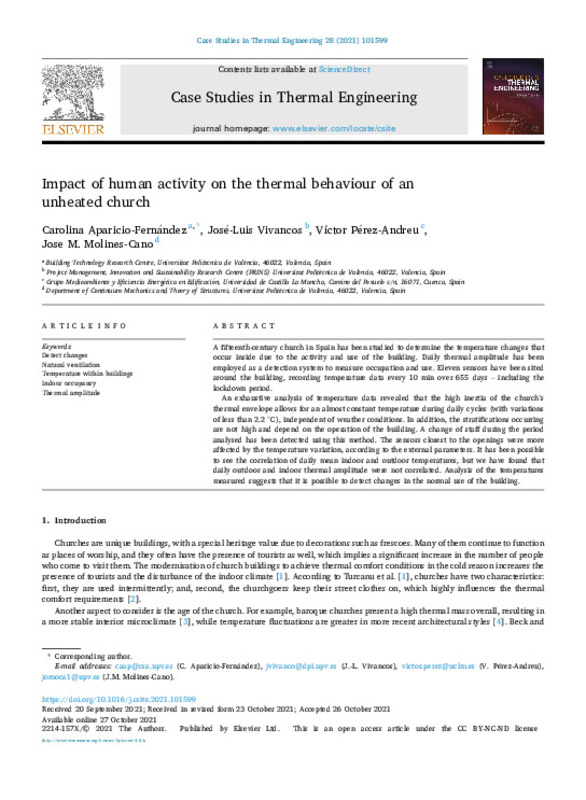JavaScript is disabled for your browser. Some features of this site may not work without it.
Buscar en RiuNet
Listar
Mi cuenta
Estadísticas
Ayuda RiuNet
Admin. UPV
Impact of human activity on the thermal behaviour of an unheated church
Mostrar el registro sencillo del ítem
Ficheros en el ítem
| dc.contributor.author | Aparicio Fernandez, Carolina Sabina
|
es_ES |
| dc.contributor.author | Vivancos, José-Luis
|
es_ES |
| dc.contributor.author | Pérez-Andreu, Víctor
|
es_ES |
| dc.contributor.author | Molines Cano, J.M.
|
es_ES |
| dc.date.accessioned | 2022-10-04T18:04:48Z | |
| dc.date.available | 2022-10-04T18:04:48Z | |
| dc.date.issued | 2021-12 | es_ES |
| dc.identifier.uri | http://hdl.handle.net/10251/186990 | |
| dc.description.abstract | [EN] A fifteenth-century church in Spain has been studied to determine the temperature changes that occur inside due to the activity and use of the building. Daily thermal amplitude has been employed as a detection system to measure occupation and use. Eleven sensors have been sited around the building, recording temperature data every 10 min over 655 days - including the lockdown period. An exhaustive analysis of temperature data revealed that the high inertia of the church's thermal envelope allows for an almost constant temperature during daily cycles (with variations of less than 2.2 degrees C), independent of weather conditions. In addition, the stratifications occurring are not high and depend on the operation of the building. A change of staff during the period analysed has been detected using this method. The sensors closest to the openings were more affected by the temperature variation, according to the external parameters. It has been possible to see the correlation of daily mean indoor and outdoor temperatures, but we have found that daily outdoor and indoor thermal amplitude were not correlated. Analysis of the temperatures measured suggests that it is possible to detect changes in the normal use of the building. | es_ES |
| dc.language | Inglés | es_ES |
| dc.publisher | Elsevier | es_ES |
| dc.relation.ispartof | Case Studies in Thermal Engineering | es_ES |
| dc.rights | Reconocimiento - No comercial - Sin obra derivada (by-nc-nd) | es_ES |
| dc.subject | Detect changes | es_ES |
| dc.subject | Natural ventilation | es_ES |
| dc.subject | Temperature within buildings | es_ES |
| dc.subject | Indoor occupancy | es_ES |
| dc.subject | Thermal amplitude | es_ES |
| dc.subject.classification | CONSTRUCCIONES ARQUITECTONICAS | es_ES |
| dc.subject.classification | MECANICA DE LOS MEDIOS CONTINUOS Y TEORIA DE ESTRUCTURAS | es_ES |
| dc.subject.classification | PROYECTOS DE INGENIERIA | es_ES |
| dc.title | Impact of human activity on the thermal behaviour of an unheated church | es_ES |
| dc.type | Artículo | es_ES |
| dc.identifier.doi | 10.1016/j.csite.2021.101599 | es_ES |
| dc.rights.accessRights | Abierto | es_ES |
| dc.contributor.affiliation | Universitat Politècnica de València. Departamento de Construcciones Arquitectónicas - Departament de Construccions Arquitectòniques | es_ES |
| dc.contributor.affiliation | Universitat Politècnica de València. Departamento de Proyectos de Ingeniería - Departament de Projectes d'Enginyeria | es_ES |
| dc.contributor.affiliation | Universitat Politècnica de València. Departamento de Mecánica de los Medios Continuos y Teoría de Estructuras - Departament de Mecànica dels Medis Continus i Teoria d'Estructures | es_ES |
| dc.description.bibliographicCitation | Aparicio Fernandez, CS.; Vivancos, J.; Pérez-Andreu, V.; Molines Cano, J. (2021). Impact of human activity on the thermal behaviour of an unheated church. Case Studies in Thermal Engineering. 28:1-11. https://doi.org/10.1016/j.csite.2021.101599 | es_ES |
| dc.description.accrualMethod | S | es_ES |
| dc.relation.publisherversion | https://doi.org/10.1016/j.csite.2021.101599 | es_ES |
| dc.description.upvformatpinicio | 1 | es_ES |
| dc.description.upvformatpfin | 11 | es_ES |
| dc.type.version | info:eu-repo/semantics/publishedVersion | es_ES |
| dc.description.volume | 28 | es_ES |
| dc.identifier.eissn | 2214-157X | es_ES |
| dc.relation.pasarela | S\451319 | es_ES |
| dc.contributor.funder | Universitat Politècnica de València | es_ES |
| upv.costeAPC | 630 | es_ES |








